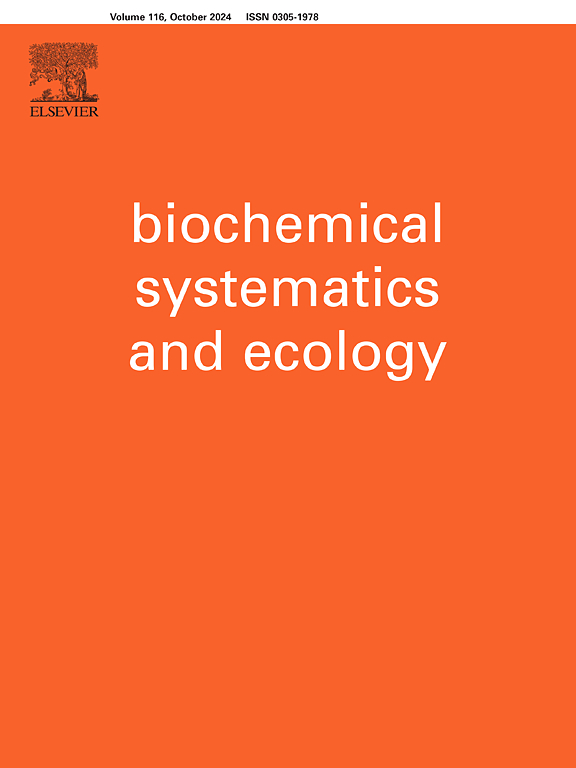肯尼亚不同农业气候区精选药用植物的植物化学变异性
IF 1.4
4区 生物学
Q4 BIOCHEMISTRY & MOLECULAR BIOLOGY
引用次数: 0
摘要
植物的药用特性取决于其植物化学成分的含量和特征。农业气候因素(如温度、日照、水分供应和土壤成分)会影响植物中具有生物活性的植物化学物质,从而影响其药用潜力。本研究调查了肯尼亚不同农业气候区的芒果、番石榴和鳄梨等选定药用植物叶片提取物的植物化学变异性。研究人员从九个不同地理区域的 227 个芒果(83 个)、番石榴(85 个)和鳄梨(59 个)品种中采集了健康的新鲜叶片样本。制备了叶片的甲醇提取物,并对总酚含量(TPC)、总黄酮含量(TFC)和抗氧化活性进行了检测。萃取物中总酚和总黄酮的分布与农业气候区无关。但是,可以观察到与地理和特定农业气候参数有关的模式。此外,相关分析表明,特定的农业气候参数对 TPC 和 TFC 有显著影响。具体而言,番石榴全生育期、鳄梨全生育期和芒果全生育期与降雨量和土壤湿度呈中度负相关。芒果全生育期与海拔和温度呈中度相关。不过,这些相关性都不高(r ≥ 0.5),这表明还有其他干扰因素的影响。在抗氧化特性方面没有观察到明显的趋势。虽然本研究确定了一些地理模式以及与农业气候参数的相关性,但 TPC、TFC 和抗氧化活性与农业气候区可能并不能最终用于描述这些药用植物的特征。未来的研究可能会缩小对特定生物活性分子和特定农业气候参数的研究范围。本文章由计算机程序翻译,如有差异,请以英文原文为准。
Phytochemical variability of selected medicinal plants from different agro-climatic zones in Kenya
Medicinal properties of plants are a factor of their phytochemical content and profile. Agro-climatic factors such as temperature, sunlight, water availability, and soil composition can influence the profile of bioactive phytochemicals in plants and hence their medicinal potential. The study investigated the phytochemical variability in leaf extracts of selected medicinal plants, mango, guava, and avocado, from different agro-climatic zones in Kenya. Fresh healthy leaves were sampled from two hundred and twenty-seven mango (83), guava (85), and avocado (59) accessions in nine different geographical areas. Methanol extracts of the leaves were prepared and assayed for total phenol content (TPC), total flavonoid content (TFC), and antioxidant activity. The TPC and TFC distribution in the extracts did not correlate with the agro-climate zones. However, patterns were observed attributable to geographical and specific agro-climatic parameters. Further, correlation analyses showed that specific agro-climatic parameters significantly affected TPC and TFC. Specifically, guava TPC, avocado TPC, and mango TFC had a moderately negative correlation with rainfall and soil moisture. Mango TFC had a moderate correlation with altitude and temperature. However, none of the correlations was high (r ≥ 0.5), suggesting the effect of other confounding factors. No discernible trend was observed with the antioxidant properties. Though some geographical patterns and correlations with agro-climatic parameters were established in the study, TPC, TFC, and antioxidant activity and agro-climatic zones may not be conclusively used to characterize these medicinal plants. Future studies may narrow on specific bioactive molecules and specific agro-climatic parameters.
求助全文
通过发布文献求助,成功后即可免费获取论文全文。
去求助
来源期刊

Biochemical Systematics and Ecology
生物-进化生物学
CiteScore
3.00
自引率
12.50%
发文量
147
审稿时长
43 days
期刊介绍:
Biochemical Systematics and Ecology is devoted to the publication of original papers and reviews, both submitted and invited, in two subject areas: I) the application of biochemistry to problems relating to systematic biology of organisms (biochemical systematics); II) the role of biochemistry in interactions between organisms or between an organism and its environment (biochemical ecology).
In the Biochemical Systematics subject area, comparative studies of the distribution of (secondary) metabolites within a wider taxon (e.g. genus or family) are welcome. Comparative studies, encompassing multiple accessions of each of the taxa within their distribution are particularly encouraged. Welcome are also studies combining classical chemosystematic studies (such as comparative HPLC-MS or GC-MS investigations) with (macro-) molecular phylogenetic studies. Studies that involve the comparative use of compounds to help differentiate among species such as adulterants or substitutes that illustrate the applied use of chemosystematics are welcome. In contrast, studies solely employing macromolecular phylogenetic techniques (gene sequences, RAPD studies etc.) will be considered out of scope. Discouraged are manuscripts that report known or new compounds from a single source taxon without addressing a systematic hypothesis. Also considered out of scope are studies using outdated and hard to reproduce macromolecular techniques such as RAPDs in combination with standard chemosystematic techniques such as GC-FID and GC-MS.
 求助内容:
求助内容: 应助结果提醒方式:
应助结果提醒方式:


